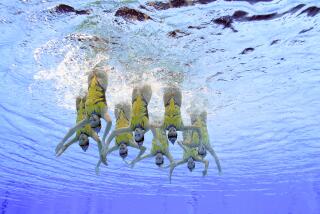Water Workout Keeps the Expectations Great
- Share via
One of the regulars is absent from the Thursday night water aerobics class at La Palma Intercommunity Hospital, but the other members have a pretty good guess as to why.
“Maybe she had the baby,” one of them speculates, and the others agree that that’s the most likely possibility, since her pregnancy was close to term.
How times change.
Back when these women’s mothers were expecting them, nobody even used the words pregnancy and exercise in the same sentence--unless they also threw in the word don’t. Expectant mothers were seen as frail creatures, and pregnancy itself was treated more as a disease than a normal, natural process.
Even healthy women with no complications were advised to take it easy from the moment the rabbit died (before the advent of home test kits and animal rights, pregnancy testing involved the sacrifice of a female lab rabbit).
As their “delicate condition” progressed, mothers were routinely ordered to rest in bed for weeks before and after delivery.
But for the present generation of mothers, exercise is not only permissible, it’s actively recommended, for the sake of both mother and baby.
“It’s better to exercise,” says Christy Velosoyap, a physical therapist who teaches the La Palma class. “During pregnancy the ligaments and muscles relax, and that can lead to joint problems. Because of the extra weight, many women can have back problems if they aren’t in shape. The more toned up you are, the less chance of complications.”
Pregnant bodies, however, may not fit into conventional exercise classes any easier than they can squeeze into those spandex outfits. For one thing, instead of increasing the heart rate as high as 160 beats per minute, as regular aerobics classes do, Velosoyap says pregnant women should bring their rates up only to about 120 beats to avoid possible harm to the fetus.
Also, the bouncing and jostling of more traditional aerobics can be damaging to muscles and connective tissue. That’s where water exercise comes in. Exercises that would be impossible on dry land become almost effortless in the water.
“The buoyancy fights the effect of gravity,” Velosoyap says.
The women themselves prove that point. As they walk from the changing room to the hospital’s rehabilitation pool (wearing maternity swimsuits--which weren’t even available a generation ago), their gait accommodates the extra weight and changing shape of their bodies. But in the water, they move as gracefully as water ballerinas, almost as if they were taking a one-hour vacation from pregnancy.
Although some women swim during their pregnancies, this class isn’t designed for that. The water is just 4 1/2 feet deep, so the women stand, sometimes holding onto a bar at the pool’s edge for support as they stretch and kick. The women themselves can control the intensity of the workout by varying how hard they push against the resistance of the water.
Midway through the class, Velosoyap has the women stop and check their pulses, just to make sure their heartbeats are not getting too high.
“We try to keep a conversation going the whole time,” Velosoyap says. “If you’re breathing too hard to carry on a conversation, then it’s not aerobic and you need to slow down.”
The conversation has an added benefit, she says: “There are so many support groups out there for all kinds of things, like AA, but pregnant people often have no other pregnant people to turn to.”
The water in the pool is a constant 94 degrees, which is necessary for the various other conditions treated with water therapy. It could be cooler for the pregnant women, Velosoyap says, but not hotter.
“You especially shouldn’t exercise in a Jacuzzi,” she says, “where the water (for therapeutic purposes) is usually about 110 degrees. That could harm the baby.”
Mary Diendorf, midway through her second pregnancy, remembers the time she had to skip class. “I was supposed to go that Tuesday night, but I went to the doctor in the morning for my checkup and two hours later I delivered, or I would have been at my exercise class. It really helps.”
Exercise also helps the body get back in shape after pregnancy, so delivery doesn’t mark the end of the class.
Because there are some pregnancy problems that may preclude exercise, all participants are required to have the consent of their physician before joining. But mothers do not have to be planning to deliver at La Palma Intercommunity Hospital in order to participate.


